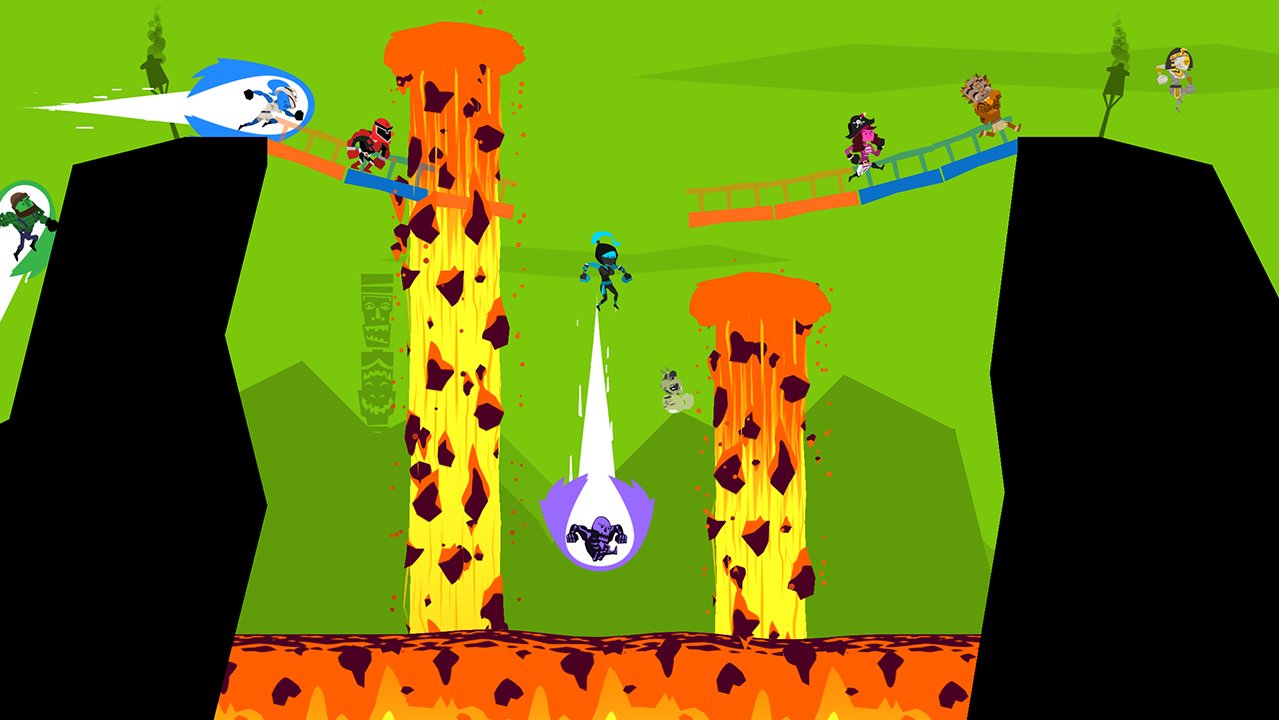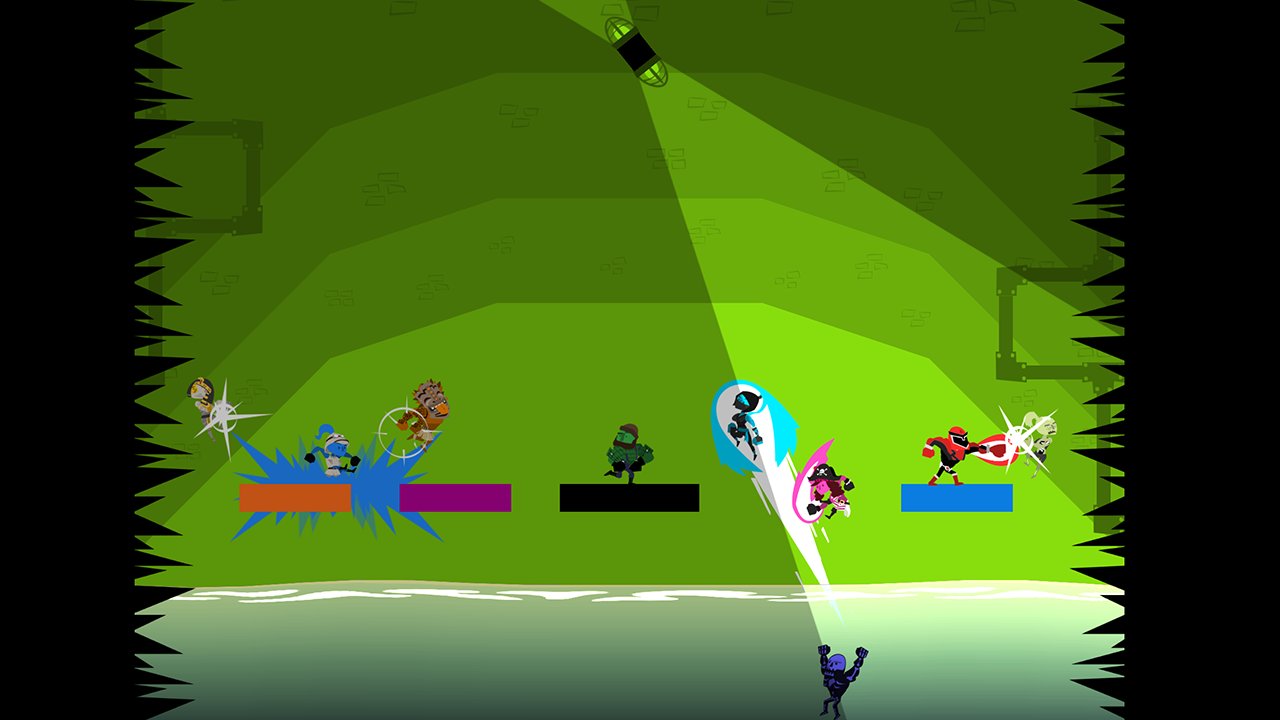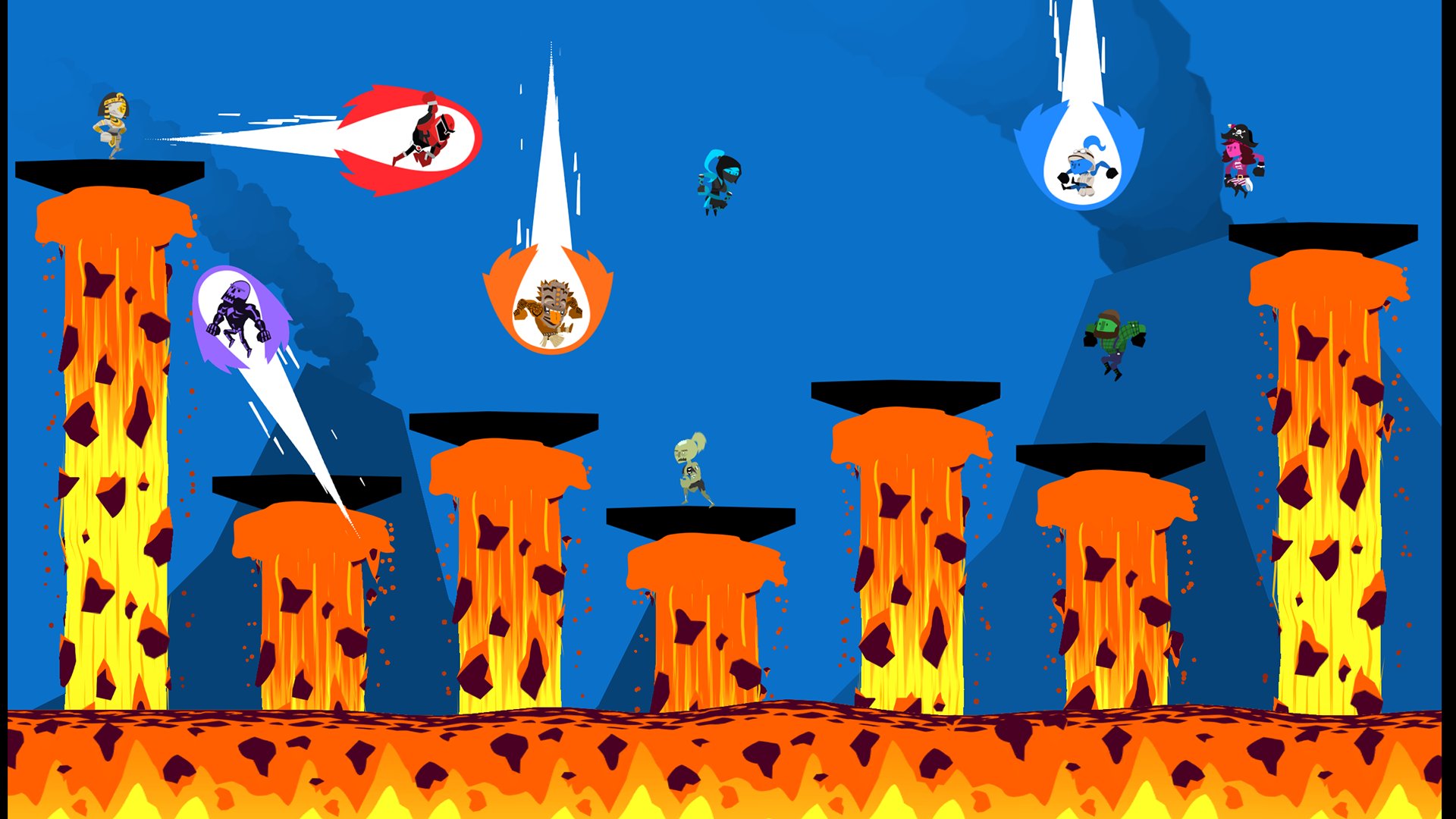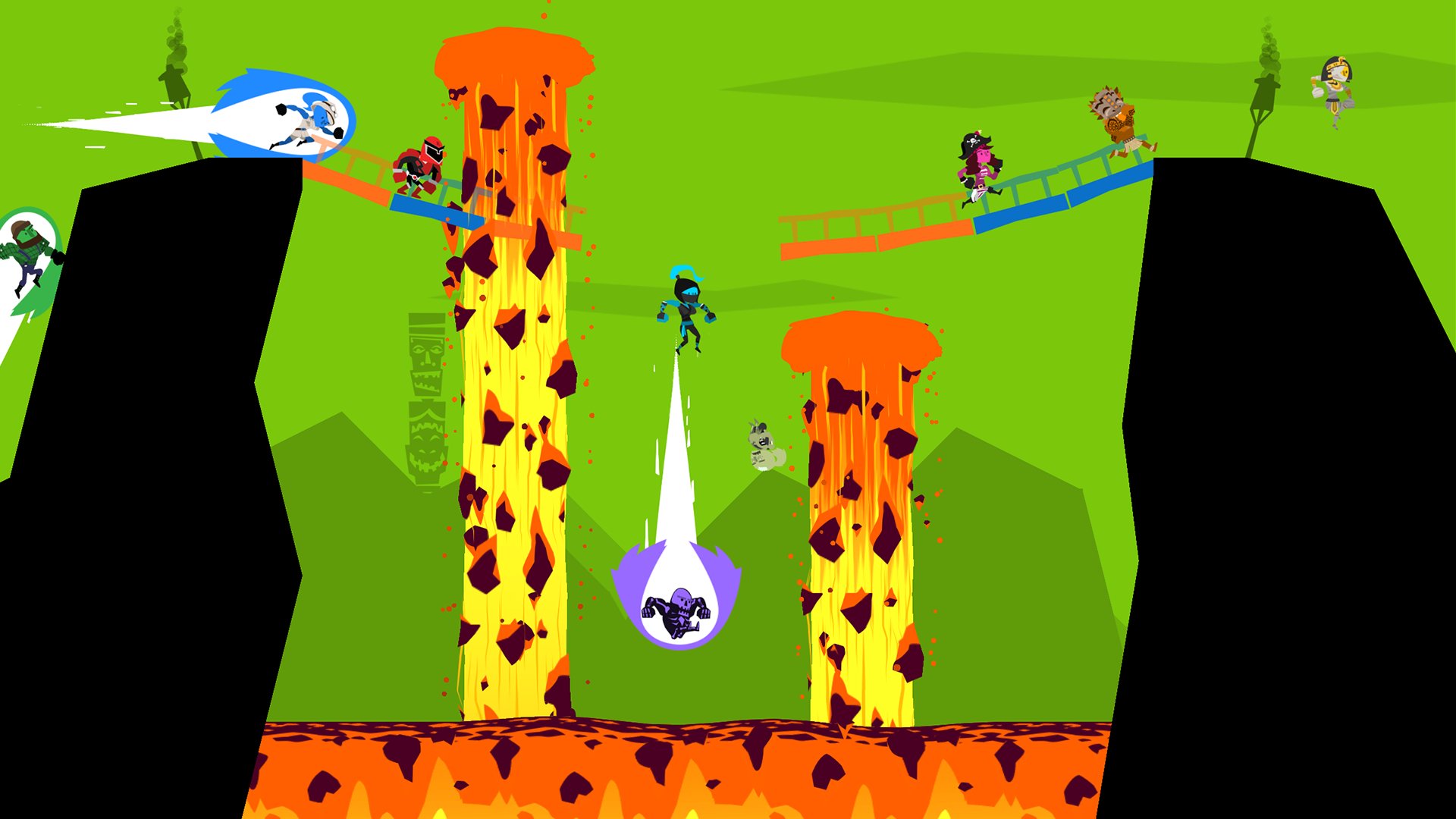Run, run, run, run(bow).
For a while we suffered through a dearth of local multiplayer options when it came to our video games, with most of us only having the chance of playing with our friends being if we joined them in an online session, effectively ensuring that we rarely needed to bother with human interaction for a few years. But then it seemed that all developers both triple-A and independent held a meeting, in which they decided that maybe they should give us more games to play whilst sitting on the couch with our buddies other than Mario Kart.
13AM Games’ Runbow has a relatively large amount of competition then, though its frantic platforming and use of well-known mascots from Shovel Knight to Guacamelee’s Juan make it a more inveigling option than many of its contemporaries. With it boasting the potential for 9-player rounds, an online mode that ensures that you needn’t have friends visiting in order to play it, and a unique single-player mode specifically tailored towards the self-proclaimed “hardcore,” Runbow is certainly packed with features. As I discovered during my time with the game, though, none of them serve to offer an experience that will prove to be a mainstay of social gatherings when the likes of TowerFall, Rocket League and Sportsfriends exist.
It’s a shame, too, because Runbow’s concept seems as though it would offer infinite amounts of fun. The game tasks the player with racing to the end of a level against up to eight rivals, with colored platforms leading them to their goal. During each stage, the color of the background frequently changes, making the corresponding platforms appear invisible. For instance, if you’re standing on a pink platform but then the background of the stage also turns pink, the platform will disappear from beneath you. This can either inconvenience you or lead to your untimely demise, and with multiple power-ups available to collect and the option of also punching and kicking your fellow competitors, each round inevitably devolves into incomprehensible mayhem.
Runbow's support of up to nine players—the Wii U version of the game I played allows the Gamepad, Pro Controller, and Wii-motes—is an inviting gimmick, but nine characters feels overcrowded. In the case of Runbow, less is more, and I found that sessions with six players were far more enjoyable as they still allowed for a modicum of skill to be employed, rather than desperately punching and jumping your way through a crowd of like-minded opponents.
Winning a round in Runbow doesn’t feel like an achievement when more players are thrown into the pot due to the inherent randomness of it all. Power-ups are deployed at will, some switching the frontrunner with the player in last place like an even more potent Blue Shell, and others granting players a swift burst of speed or turning the entire playing field upside-down. It’s complete chaos, and when I came out of a round victorious, I felt like I had earned it not because of my talent in navigating its various platforms and obstacles, but out of luck that I hadn’t been as impeded as much as my rivals.
That’s not to say that Runbow rewards luck more than it does skill. Given its reliance upon reaction times, this isn’t a game for those who aren’t already well-versed in the platforming genre—you’re going to need to be quick on your feet if you want to succeed in the game, which will instantly write out those who have a more casual appreciation of platformers or video games as a whole. This will inevitably make it more appealing for those who aren’t big fans of the high level of accessibility offered by many party games, and it certainly makes it one of the more challenging multiplayer-centric games around.
In terms of the many different stages that the game features, some offer a straight-forward surge to the trophy at their finishing line, while others task players with solving problems in order to successfully navigate them. The levels are dished out at random and each place their own color-based stumbling blocks in front of you, all of which must be confronted as you mercilessly fend off your fellow runners.
The game features four different multiplayer modes: Run, where you must simply race to the end; The Arena, which sees players fighting to the death in stages more often than not filled with deadly lava; King of the Hill, which tasks players with taking control of a certain portion of a stage for a period of time; and its most inventive mode, ColorMaster, which arms one player with the GamePad and allows them to place various obstacles in the paths of the other players, along with changing each level’s background at will.
It’s a varied selection of modes with each having their own unique selling points, though ColorMaster is the mode that will likely be played the most, given its utilization of the oft-overlooked GamePad. Though it’s not the star attraction and deviates from Runbow’s core concept, I also enjoyed The Arena given its similarities to TowerFall and it offering a greater sense of reward than the game’s more traditional modes. I frequently found myself stuck in hard-fought battles where I’d be forced to battle above a fiery pit of doom, like a reenactment of the Obi-Wan/Anakin battle in Revenge of the Sith… only with more Shovel Knight.
With the exception of ColorMaster these modes all make their way online, though the Wii U’s problems as an online multiplayer service hold the game down somewhat. While I cannot attest to the quality of the connections in Runbow’s Steam version, I should imagine it is more accomplished than what I experienced on the Wii U. It isn’t broken by a long stretch, but it certainly isn’t in pristine working order either. Games frequently lag when more players are added into the fold, characters judder across the scene, and their feet fail to register with platforms forcing them to awkwardly float in the middle of a stage. While the game runs more-or-less smoothly the majority of the time, it is still prone to these outbursts of connectivity issues that make online play a more inconsistent experience than when it’s experienced offline.
Runbow also offers solo players a couple of modes to sink their teeth into, the first being an Adventure mode which tasks them with running through a selection of levels across four worlds, completing objectives along the way. This can also be played with friends, and it’s more fun when experienced that way, but altogether it’s a bare-bones mode that won’t hold your attention for too long.
Fortunately, its unique Bowhemoth offers a much more enjoyable time, with it featuring a selection of challenges to overcome punctuated by checkpoints but no option to save. This means that the Bowhemoth must be completed in one single run, and given that each of its challenges increases in difficulty until they eventually appear to be nigh-on impossible, those who are playing Runbow by themselves can sink a relatively large amount of time into completing this grueling challenge, even if its solo game modes aren’t exactly what people will be buying Runbow for.
All in all, Runbow is a decent party game that offers some laughs and a nice amount of variety, though it is unfortunately not as accomplished as other similar games. It’s certainly worthy of your attention if you frequently have guests in your home looking to play some fun new video games, but don’t expect it to boast the same kind of longevity as its local multiplayer contemporaries, especially on a console that already boasts the likes of Mario Kart 8, Super Mario 3D World, Nintendo Land, and Super Smash Bros.
-
A nice variety of modes
-
Something for the solo player to enjoy in the form of the Bowhemoth
-
When it’s at its best, it can produce some frenetic, hilarious moments
-
ColorMaster mode is unique and inventive
-
Playing with the full 9 players is often overly chaotic
-
Online multiplayer has connectivity issues a little too frequently
-
Victories often feel like they’re earned through luck rather than skill
-
Isn’t a particularly accessible party game
runbow
-
runbow #1

-
runbow #2

-
runbow #3

-
runbow #4

-
runbow #5

-
runbow #6

-
runbow #7

-
runbow #8

-
runbow #9

-
runbow #10

-
runbow #11

-
runbow #12

-
runbow #13

-
runbow #14

-
runbow #15

-
runbow #16

-
runbow #17

-
runbow #18

-
runbow #19

-
runbow #20

-
runbow #21

-
runbow #22

-
runbow #23

-
runbow #24

-
runbow #25

-
runbow #26

-
runbow #27












